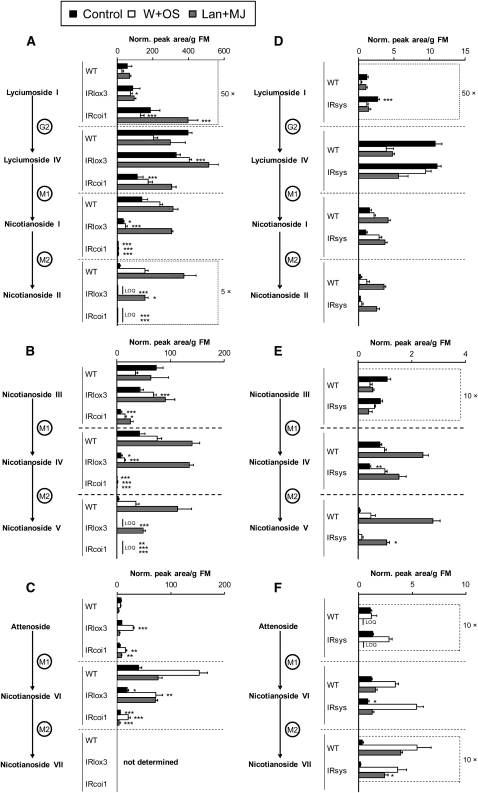Figure 5.
Malonylation of HGL-DTGs Is Regulated by JA Signaling and Tuned by ppHS Signaling.
(A) to (C) Experiment 1: wild type, IRlox3, and IRcoi1.
(D) to (F) Experiment 2: IRsys and the wild type.
Elongated N. attenuata plants were left unelicited (Control), or one leaf per plant was elicited with W+OS to mimic herbivory, with 150 μ g MJ in lanolin paste to supplement JA production. Elicited leaves were harvested at 3 d. Plants impaired in JA biosynthesis (IRlox3) and perception (IRcoi1) or in systemin-mediated signaling (IRsys) were compared with wild-type plants in two separate experiments using identical methods. In this figure, we compare levels of each HGL-DTG among silenced lines and the wild type, which have received the same treatment. Lanolin paste (lan) was used to control for solvent effects for the lan+MJ treatment, and the effects of treatments within genotypes are shown in Supplemental Figure 3 and Supplemental Tables 4 and 5 online. Asterisks indicate significant differences from the wild type in one-way ANOVAs (wild type, IRlox3, and IRcoi1; [A] to [C]) or Student's t tests (wild type and IRsys; [D] to [F]) within each treatment: *P ≤ 0.05, ** P < 0.01, and *** P < 0.001 in Bonferroni-corrected tests. (Student's t tests were also subjected to the Bonferroni comparison as the same data were used to analyze the effect of treatment on HGL-DTG accumulation within genotypes.) Each graph represents the full biosynthetic pathway from glycosylation through malonylation for one set of HGL-DTGs. For example, in (A), IRcoi1 plants accumulate the precursor lyciumoside I (average + se; n = 5 plants) and are impaired in their ability to convert it to the core compound lyciumoside IV at a wild-type rate, especially after lan+MJ treatment; IRlox3 plants accumulate lyciumoside IV, especially after W+OS elicitation. Both IRcoi1 and IRlox3 are unable to malonylate lyciumoside IV in control and W+OS-elicited leaves. Malonylation is recovered in IRlox3 and not in IRcoi1 by lan+MJ. By contrast, in (D), IRsys plants are able to synthesize wild-type levels of lyciumosides IV and nicotianosides I and II, but like IRcoi1, accumulate lyciumoside I in unelicited tissue; however, in (E) and (F), IRsys plants are unable to accumulate wild-type levels of other dimalonylated HGL-DTGs (nicotianosides V and VII) after lan+MJ treatment. Note that some compounds have been multiplied by constants to fit the scale of the graph and that scales change among graphs. LOQ, below limit of quantification.

